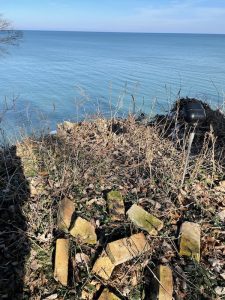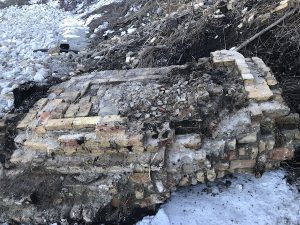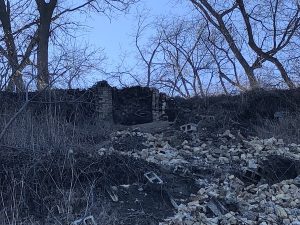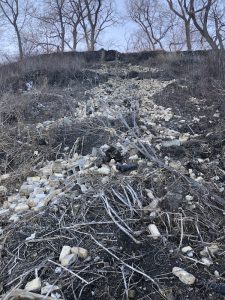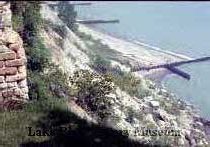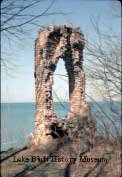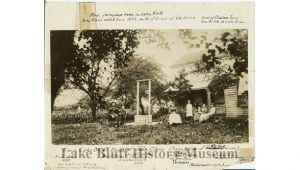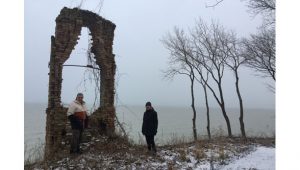The Stearns Chimney has fallen. We hope the majestic remnant chimney that spanned three centuries overlooking Lake Michigan made a crashing roar when the last of its yellow-pink bricks dislodged and tumbled down the bluff in early March 2022. If the end came during daylight, we hope a flock of gulls flew by, screeching. If it happened by the light of the waxing crescent moon, we like to imagine a lone coyote angled its head to the sky and howled.
The exact time of the chimney’s demise isn’t known. Its longtime caretakers Neil and Mary Dahlmann saw the chimney from their picture window at breakfast on Monday, March 7, as they had every day for decades.
The next morning it was gone.
“We always knew that someday the chimney would tip over, and we’d wake up and it would no longer be here,” said Mary.
The old chimney’s hold on the edge of their Bluff Road property in Lake Bluff had been perilous for years, as waves and winds pummeled the bluff and gradually eroded the earth beneath the chimney’s brick foundation. Neil and Mary, and Neil’s parents before them, tried shoring up the bluff for decades. They planted native grasses with long roots, built a retaining wall, and had stone revetments installed where a sandy beach long ago washed away. These efforts probably bought the chimney a number of additional years.
“You can’t win against nature, but I’m sure they slowed it down,” said their daughter Jill, who married her husband, Andrew Rosa, at the chimney in 1997.
The Dahlmanns’ property is significant to Lake Bluff history: it was the first parcel claimed here after the 1833 treaty of Chicago opened the area to settlers, and only three homes have stood on the land all this time.
The first owners were German immigrants John & Catherine Cloes (originally Kloes), who in 1836 made their way north from Chicago along the shore with their son Henry. The Cloes laid claim to 100 acres of densely wooded lakefront land for $1.25 an acre. They cleared 10 acres for a family farm, and built a blacksmith shop near the Green Bay Trail for John and a log cabin near the lake for the family, which eventually grew to comprise seven children. In 1855 Catherine started a brickyard nearby with her sons.
In 1895 the Cloes family sold seven acres to newspaper publisher A.K. Stearns, who built a wood-frame house at least 75 feet from the bluff. In the middle of the house was a 16-foot chimney made of bricks that likely came from the Cloes Brickyard.
Ben Cloes wrote that during the almost 60 years he was in Lake Bluff, from 1847 to 1905, approximately 50 feet of land along the bluff washed away due to storms and waves. It also has been said that the 1910 construction of the harbor at Naval Station Great Lakes, about 1.5 miles north of Lake Bluff, changed the lake flow along the shore and increased erosion problems over time.
In 1948, after Stearns’ death, erosion had worsened so much that his home was quite near the bluff. It stood empty for years and eventually was destroyed by fire. Well, almost destroyed: the stately brick chimney survived. Another house, designed by Frank Lloyd Wright, was built just south of the Stearns house. In the 1950s an architect purchased the property and sub-divided it into three lots. The south lot went to Gil & Pat Curren, the north lot to David & Eleanor Hall.
The center lot went to Neil’s parents, Bernard and Eleanora Dahlmann. In 1965, they built a mid-century-style house with picture windows that afforded a clear view of trees, lake, sky – and chimney. Some homeowners may have considered the decaying brick structure a blight on their lakefront view, but not the Dahlmanns. Eleanora even painted an image of the chimney on door panels in her kitchen so that she could see its distinctive outline when the doors were closed.
Neil and Mary inherited the house in 1995. They initially put the property on the market, but the more they came to check on the house, the more they liked it and Lake Bluff. They moved to Bluff Road in 1996, and they did some renovations on the house but maintained the prime view of the chimney, which was then quite near the bluff.
Over the years, the chimney became even more endearing as its center hole began to resemble a bottle of Absolut vodka, a shape made famous in print ads in the 1980s and ‘90s.
And generations of sailors, kayakers, paddle boarders and lake swimmers used the chimney to mark their distance and know when to turn home while out on the beautiful, unpredictable and often turbulent Lake Michigan.
Today there’s a gouge in the ground where the chimney once stood, and an emptiness to the landscape on the bluff. It’s as if a passage to another world has washed away.
But memories run deeper than the roots of native grasses and are stronger than even the fiercest waves.

